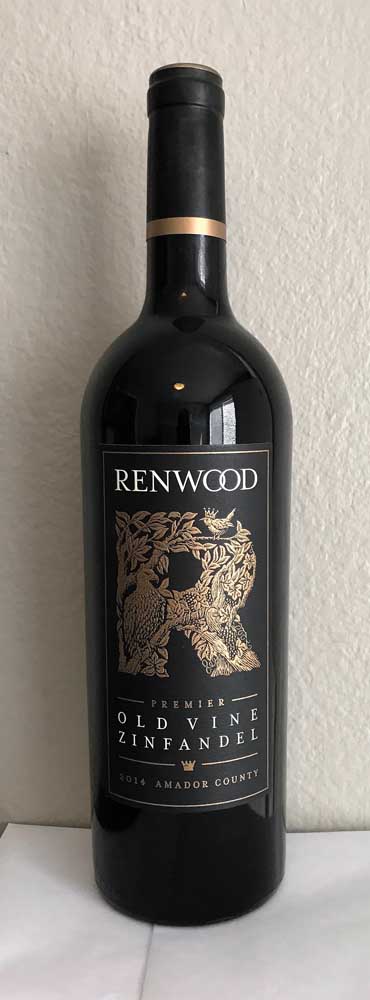The zins of the forefathers
Published 11:56 am Thursday, July 20, 2017

- The 2014 Renwood Premier Old Vine Zinfandel ($19.99) is a blend of 85 percent zinfandel grapes with petite sirah, barbera and syrah. (Submitted photo)
One of the most enigmatic of wines is zinfandel. Is it red or white? A California original or of European ancestry? From old vines or young?
More than 10 percent of all California vineyards produce this black-skinned grape, but it still is rarely acknowledged in the same breath as Cabernet, Merlot or Chardonnay.
Trending
There’s a reason. Although zinfandel was first planted in California in the 1850s and was the most widespread variety in the state at the turn of the 20th century, it had become so obscure by the 1970s that its origins had been forgotten.
The trials of the Prohibition era concentrated grapes for home winemaking in the state’s Central Valley region, whose piercing summer heat is not optimal for quality zinfandel. Most grapes from this region now are used for box wines and semi-sweet whites.
Fortunately for contemporary wine drinkers, a few “old vines,” pre-dating Prohibition, were salvaged in Amador County, in the Sierra foothills region east of Sacramento, and in the Dry Creek Valley north of Healdsburg in the upper Sonoma Valley. Today these regions produce the Americas’ finest zinfandels.
True zinfandel is a full-bodied red wine, although the name is sometimes erroneously applied to a rosé wine called white zinfandel. The “white” version, which derives from the same grape, is dramatically different from the red. Today, it accounts for nearly 10 percent of U.S. wine sales by volume, six times that of red zinfandel, although that ratio is gradually changing.
Adriatic ancestry
Zinfandel’s heritage can be traced to the Dalmatian coast of Croatia on the Adriatic Sea. Popular in Europe as Plavac Mali (in Croatia) and Primitivo (in southern Italy), it was imported to New England via Austria in the 1820s, and arrived in California a generation later.
Trending
White zinfandel originated at Napa’s Sutter Home Winery. In 1972, when demand for white wine was greater than the availability of white-wine grapes, California producers were encouraged to make “white” wine from red grapes with minimal skin contact. In draining juice from vats to provide more color to a dry red Zin, Sutter Home owner-winemaker Bob Trinchero experienced a “stuck fermentation”: Yeasts died off before all sugar had been converted to alcohol. He decided to try selling the pink, medium-sweet wine, which became instantly popular. Ironically, the success of this blush saved many old vines as red Zin came back into fashion at the end of the 20th century.
While zinfandels may be found in growing regions throughout California, including Napa, Mendocino, Paso Robles and Santa Cruz, the old vines of Amador County (near Plymouth) and Sonoma’s Dry Creek Valley make the finest wines of this varietal. These vines, upwards of 120 years old, produce smaller crops of more concentrated, intensely flavored grapes, much different than in newly planted vineyards.
The zinfandels of Amador County, near State Highway 49 in the California gold country, are big, full-bodied reds. Most have a jammy character that speaks of blackberries and black cherries, accented by vanilla and licorice. Lodi, about 25 miles southwest of Amador, is best known for its white zins, but its red zins are juicy and very approachable, and generally lower priced than Amador.
Dry Creek zinfandels tend to be slightly more balanced, their bright berry flavors led by more pepper on the palate and often some chocolate on the finish.
Like other zins, these wines are well paired with hearty meats such as lamb shank or barbecued ribs.
Winemaker Scott Harvey, of Amador’s Santino and Renwood wineries, describes the difference between old-vine and young-vine zinfandels as reflecting the depth of soil to which the roots extend — as many as 25 feet for old vines, often no more than 6 feet for young vines. Not only do multiple layers of soil add more dimension to the grapes, Harvey said; deeper roots are better able to withstand the extremes of wet and dry years to ripen and mature consistently. Thus old-vine zins can be expected to have far more complexity of flavor than their offspring.
Three to consider
These old vines zinfandels, currently available in Central Oregon, are three that I especially like:
The 2013 Bucklin Old Hill Ranch Ancient Field Blend ($25.99) comes from a 12-acre block of Sonoma vines planted in 1885.
While it is dominantly made from zinfandel grapes, the wine is co-fermented with more than two dozen other varieties of grapes, including Grenache, Alicante Bouchet, Petite Sirah, Mourvedre, Syrah, Carignane and Tempranillo. The result is a bold, dark, high-alcohol (15.3 percent) wine with strong berry flavors, licorice and pepper.
The 2014 Renwood Premier Old Vine zinfandel ($19.99) is produced in Amador County, aged 20 months in French oak, has strong blackberry and cocoa notes with layers of strawberry and licorice. Tannins are integrated to a silky finish. The blend here is 85 percent zinfandel, 6 percent petite sirah, 5 percent barbera and 4 percent syrah.
The 2014 Klinker Brick Old Vine Zinfandel ($17.99) is one of the best from Lodi. Ripe blueberry and blackberry flavors, with a hint of sweetness, blend with a hint of black pepper and lead into a lingering finish.
Zinfandel grapes typically grow in large, tight bunches that bud early, ripen early and produce juice with a high sugar content, often leading to alcohol levels about 15 percent. While the flavor reflects the terroir, it also shows an individual winemaker’s skill and style in controlling the ripeness of grapes at harvest, the length of fermentation and oak aging, the extent of skin contact and other factors.
John Gottberg Anderson can be reached at janderson@bendbulletin.com.







